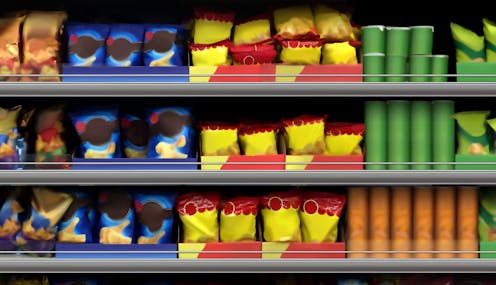As Coles slashes its product range, will well-known brands disappear from supermarket shelves?
- Written by Flavio Macau, Associate Dean - School of Business and Law, Edith Cowan University

Coles is reducing its product range by at least 10%, a move that has sparked public backlash[1] and renewed discussions about the role of supermarkets in the cost-of-living crisis.
In cutting the range of items on offer[2] Coles is moving closer to Aldi and Costco’s strategy[3] to grow exclusive brands and limit product range.
The goal is to boost profitability by reducing costs, increasing sales, and increasing control over the supply chain.
Coles is unlikely to cut traditional brands, especially those from companies with significant market power like Coca-Cola or Nestle. In a battle between giants, the status quo is likely to prevail.
Smaller suppliers are likely to bear the load as they struggle to renew contracts and face increased competition from home brands.
To fully understand the reasons behind this move and its impact on the cost of living, insights from psychology, finance, and supply chain management come in handy.
Why cut back on brands?
The Coles move is all about profitability.
Over the past decade, competition in the Australian supermarket sector has intensified. Coles’ market share[4] declined from 31% to 25% between 2013 and 2023, while Woolworths’ share[5] fell from 41% to 37%.
This shift reflects the rise of Aldi, which now holds approximately 10% of the market, and its strong position in the home brand space.
To boost profitability with a smaller customer base, Coles needs to find ways to enhance its earnings. This can be achieved by raising prices, cutting costs, or increasing the market share of its home brands.
Raising prices vs cutting costs
Raising prices is not a viable option, as consumers are already struggling with high food prices inflation and the rising cost-of-living. However, there is room to cut costs.
One approach is to squeeze suppliers, but again this is unlikely to be effective. The consumer watchdog, the Australian Competition and Consumer Commission (ACCC), is holding an inquiry[7] into concerns that the supermarkets are using their market power to the disadvantage of their suppliers and consumers.
Additionally, as producers exit unprofitable businesses, supermarkets risk supply chain disruptions due to increased market concentration among surviving suppliers.
Another strategy is to reduce complexity. The more product variety there is, the more complicated and expensive it becomes to manage. Tasks such as stocking shelves, adjusting prices, maintaining inventory, managing delivery schedules, and disposing of expired products all contribute to higher costs.
Anna Croft, Coles’ operations and sustainability officer, explained the strategy when telling investors in November that 13 basic table salts could be cut to five[8].
Simplifying the product range can also boost sales. When faced with too many options, consumers can experience “choice overload”. A widely recognised study in psychology[9] found that people are more likely to make a purchase when presented with a limited selection rather than an extensive array of choices.
Shifting to home brands
Simplifying the range will likely focus on items where Coles has a home brand. Home brands now account for 33.5% of Coles’ sales[11], with 6,000 products. About 1,100 were added over the past year.
This move is a response to competitors like Aldi and Costco. While Coles and Woolworths manage over 25,000 items in their stores, Aldi limits its offering to about 1,800 products[12].
Coles is focusing on its home brands to better compete with non-branded offerings from Aldi. In its report to the ACCC, the supermarket highlights its investment in expanding its own-brand range to provide more affordable prices, up to 40% cheaper[13] than similar proprietary brands.
While consumers may have fewer choices, it is expected that they will benefit from better prices.
This shift towards home brands is not exclusive to Australia. In the United States, private label sales hit a record in 2023[14] across a range of items from beauty products to general merchandise. In the United Kingdom, home brand products now account for over half of supermarket sales[15].
Have we been here before?
Almost 10 years ago, Woolworths and Coles started a significant move to adjust their price positioning in response to the competition. Along with Metcash (IGA), they reduced product ranges in 2015–16 by 10% to 15%[16] to simplify the weekly grocery shop for consumers.
At that time, the culling of products put suppliers under pressure (as now) while consumers were ambivalent[17]: some wanted more brand variety and others preferred less.
As history repeats itself, it will be interesting to see if Woolworths and Metcash will follow the latest move from Coles and how customers, suppliers, and the ACCC will react this time.
References
- ^ public backlash (www.news.com.au)
- ^ cutting the range of items on offer (www.afr.com)
- ^ Aldi and Costco’s strategy (www.anzam.org)
- ^ market share (www.statista.com)
- ^ Woolworths’ share (www.statista.com)
- ^ Audreycmk/Shutterstock (www.shutterstock.com)
- ^ holding an inquiry (www.accc.gov.au)
- ^ 13 basic table salts could be cut to five (www.theguardian.com)
- ^ study in psychology (psycnet.apa.org)
- ^ I.K.Media/Shutterstock (www.shutterstock.com)
- ^ 33.5% of Coles’ sales (www.colesgroup.com.au)
- ^ 1,800 products (www.aldiunpacked.com.au)
- ^ up to 40% cheaper (www.accc.gov.au)
- ^ private label sales hit a record in 2023 (www.grocerydive.com)
- ^ over half of supermarket sales (www.kantar.com)
- ^ reduced product ranges in 2015–16 by 10% to 15% (www.accc.gov.au)
- ^ consumers were ambivalent (retailworldmagazine.com.au)
Authors: Flavio Macau, Associate Dean - School of Business and Law, Edith Cowan University







